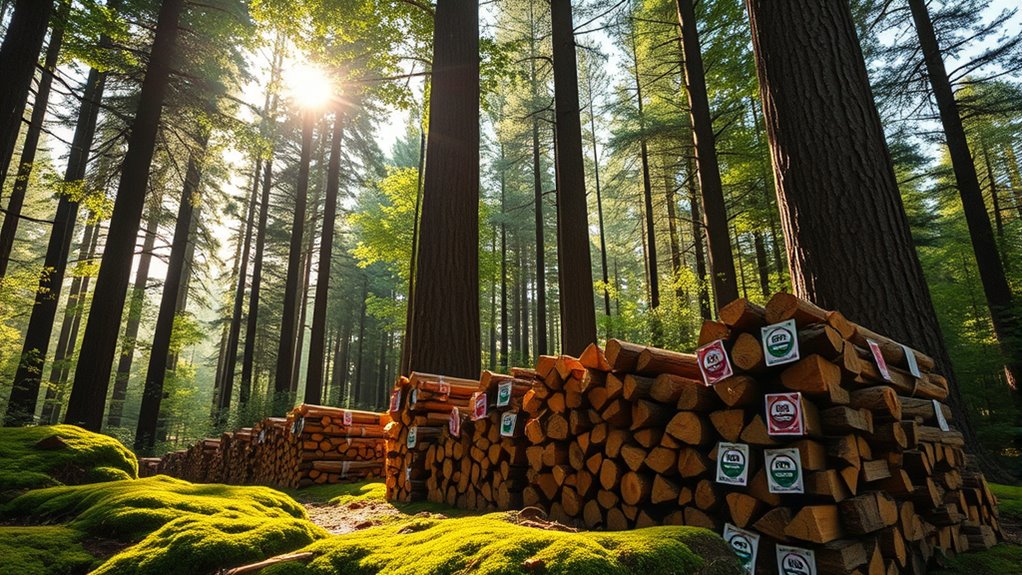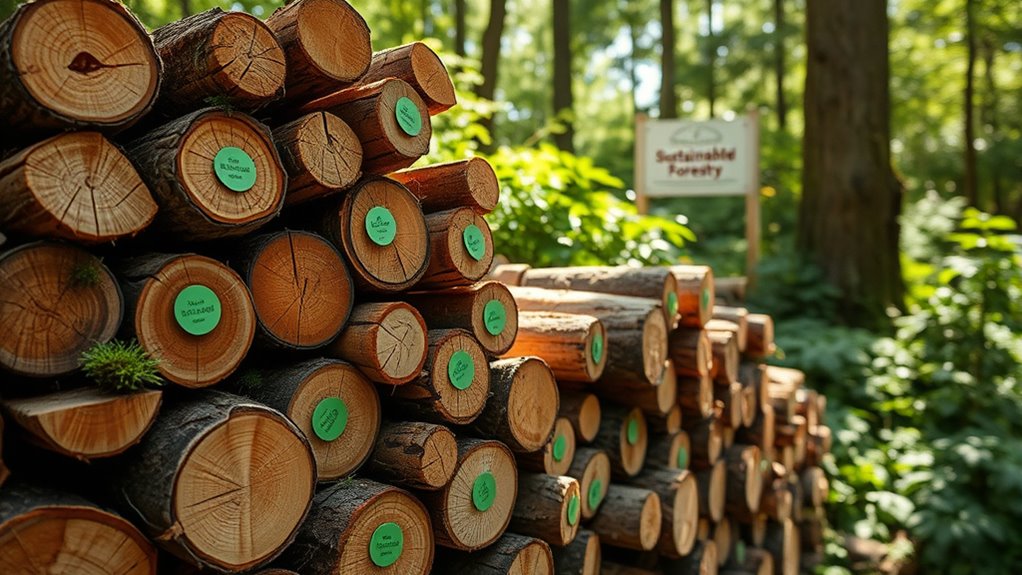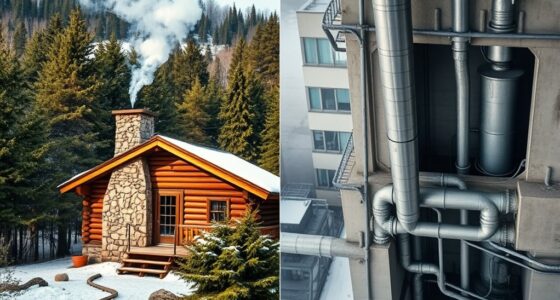Choosing certified firewood shows you’re supporting responsible forest management that benefits the environment, local communities, and future resources. These certifications guarantee the wood comes from well-managed forests following strict standards for biodiversity, water quality, and social responsibility. Your support helps reduce illegal logging and promotes sustainable harvesting practices. If you want to understand how these standards work and make truly eco-friendly choices, keep exploring further.
Key Takeaways
- Certified firewood ensures it is sourced from responsibly managed forests adhering to environmental and social standards.
- Certification standards promote sustainable harvesting to prevent overharvesting, illegal logging, and ecosystem damage.
- Buying certified firewood supports forest regeneration, biodiversity, water quality, and soil health for future generations.
- Certification provides transparency and accountability through regular audits, helping consumers identify genuinely sustainable products.
- Using certified firewood reduces environmental impact and promotes responsible forest management practices aligned with ecological values.

Sustainable forestry certifications play a crucial role in ensuring that wood and paper products come from responsibly managed forests. When you choose firewood that’s certified, you’re supporting practices that prioritize environmental health, social responsibility, and economic viability. These certifications are based on rigorous standards that promote sound forest management, ensuring that harvesting activities don’t harm ecosystems or deplete resources. By understanding these certification standards, you can make informed decisions and contribute to a more sustainable future for forest resources.
Forest management is at the heart of sustainable forestry certifications. It involves carefully planning and implementing practices that balance the needs of the environment, local communities, and the timber industry. Certified forests are managed in a way that maintains biodiversity, conserves water quality, and preserves soil health. When you purchase firewood from certified sources, you’re encouraging forest managers to follow responsible practices that prevent overharvesting and illegal logging. This not only helps protect the forest’s long-term health but also ensures that future generations can enjoy its benefits.
Certified forests are managed to protect biodiversity, water quality, and soil health for future generations.
Certification standards provide clear guidelines that forest managers must meet to earn and maintain certification. These standards cover a variety of critical aspects, such as the protection of wildlife habitats, the minimization of environmental impacts, and the fair treatment of workers. They also promote transparency and accountability, requiring regular audits and assessments. By adhering to these standards, certified forests demonstrate their commitment to sustainable practices. When you select firewood from these sources, you’re effectively supporting forest stewardship that aligns with ecological and social values.
You might wonder how these certifications impact your choices. When you buy firewood from certified sources, you’re helping to reduce illegal logging and deforestation, which are major threats to global forests. Certified firewood often comes with guarantees that the wood was harvested responsibly, respecting local laws and indigenous rights. This assurance means you’re not contributing to environmental degradation or social injustices linked to unsustainable practices. Plus, certified firewood is typically harvested with methods that prioritize forest regeneration, ensuring that the wood supply remains sustainable over time. Additionally, choosing certified firewood encourages the adoption of sustainable harvesting techniques, supporting long-term forest health and productivity. Recognizing the importance of forest certification can motivate more consumers to make environmentally responsible choices.
A deeper understanding of certification standards can also help consumers identify genuinely sustainable products and avoid greenwashing.
Frequently Asked Questions
How Do Certifications Impact Firewood Pricing and Availability?
Certifications influence firewood pricing and availability by boosting certification benefits, which appeal to eco-conscious buyers and often command higher prices. This market influence encourages sustainable harvesting practices, ensuring steady supply. As a result, you might find certified firewood more reliable and slightly more expensive, but it supports environmentally friendly forestry. Overall, these certifications help balance demand and supply, promoting sustainable management while maintaining fair pricing for consumers like you.
Are All Certified Forests Free From Environmental Risks?
No, not all certified forests are free from environmental risks. While certifications guarantee responsible practices, some risks like threats to wildlife habitats and illegal logging still exist. You should stay informed about certification standards and local conditions. Even certified forests may face challenges, so it’s wise to verify the source and support sustainable efforts that actively protect wildlife and combat illegal activities.
Can Certified Firewood Be Sustainably Sourced in Urban Areas?
Sure, you can get sustainably sourced firewood in urban areas, but don’t expect a magic wand. Urban harvesting faces certification challenges like limited access to certified forests and the risk of illegal logging slipping through the cracks. While it’s possible, you’ll need to be a savvy shopper, asking tough questions and trusting your supplier’s honesty. It’s a delicate dance, but with vigilance, you can warm your home responsibly.
How Do Certification Standards Vary Between Countries?
You’ll find that international standards for certification differ between countries, reflecting local forestry practices and regulations. Certification differences often include criteria for sustainable harvesting, forest management, and environmental impact assessments. Some countries align closely with global standards like FSC or PEFC, while others adapt them to regional needs. This variation ensures certifications remain relevant locally but can cause confusion for consumers seeking universally recognized sustainable firewood.
What Is the Process for Verifying Firewood Origin and Certification?
Imagine tracking a precious gem from mine to jewelry box; verifying firewood follows the same path. You check the chain of custody documentation and look for certification labels on the wood. These labels confirm the origin and sustainable harvesting practices. The process involves inspectors verifying each link in the supply chain, ensuring the firewood’s certification is legitimate and intact, giving you confidence in its eco-friendly credentials.
Conclusion
By choosing certified firewood, you’re supporting healthy forests and a sustainable future. But what if the firewood you buy isn’t truly eco-friendly? The stakes are higher than you think—your choices today could determine the forests of tomorrow. Will you take the responsible route and make a difference? The power is in your hands. Stay vigilant, ask questions, and guarantee your wood fuels a better, greener world. The future depends on it.











